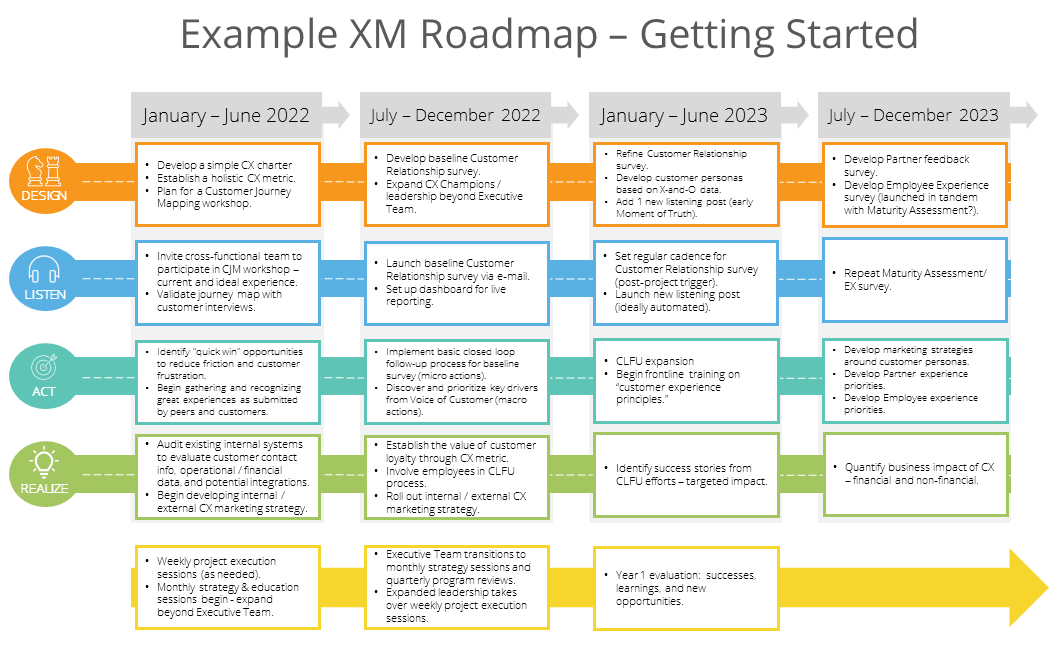
Who doesn’t appreciate a good roadmap? Through its evolution from accordion-folded paper the size of a poster to interactive app on a handheld device, a roadmap shows the way from where you are to where you want to go. Great, right? And whether you’re talking about a cross-country road trip or the journey to building a goal-oriented experience management (XM) program, a roadmap is an essential tool to help you get there.
Deciphering the XM program roadmap—What is it exactly?
In simplest terms, think of an XM program roadmap as a longer-term project plan—a tangible, navigable representation of how a company intends to build its XM program and transform its business over time. Spanning months or perhaps even up to two years, the roadmap plots a path for what successful experience management will look like for an organization.
For a lot of businesses, regardless of where they fall on the scale of XM maturity, an XM program roadmap can be a rallying cry and motivator. Inherently, the process of developing one gets companies thinking about the role experience management can play for various company stakeholders, including customers, partners, and employees. It also serves as the centerpiece deliverable for the LEAD competency—one of six essential XM competencies needed for companies to architect, align, and sustain XM efforts.

Just as your roadmap for that cross-country trip displays interstates, roadways, and points of interest, an XM program roadmap exhibits its own set of characteristics. Pulling together 12 to 24 months of strategic, experience-focused initiatives, the XM program roadmap:
- Is tangible but remains fluid with one of its attributes being that it will evolve in response to new information, lessons learned or changes in the competitive marketplace.
- Maintains high visibility inside the organization from the C-suite down to the frontline employees charged with gathering insights and acting on them.
Organized visually using a framework that plots a series of projects along a timeline (generally structured by quarters within a year), the roadmap can include a wide range of initiatives—some large, some small, some concrete and some speculative. For example, a roadmap focused on experience management might list a two-hour training on XM for senior leaders alongside the launch of a customer loyalty survey.
This journey needs a roadmap—Here’s why
Reaching your destination is only possible when you follow a thoughtfully charted course. For businesses that want to arrive at greater business success through improved experiences, an XM program roadmap helps keep experience management front and center and your eyes on the road. In meeting XM program milestones, a roadmap helps an organization:
Stay focused. It’s easy for companies to get mired down in the details of XM—deploying the same surveys and gathering the same insights—that they lose sight of the bigger picture and the broader horizon. Taking the time to develop a tangible roadmap—plotting your course, so to speak—and revisiting it at regular intervals enables you to stay focused on XM for the longer term.
Break down silos. Silos tend to become more evident—and more problematic—when it’s time to facilitate the change and transformation that good experience management requires. When departments and functions team up to create a roadmap and jump in the car together, so to speak, getting past the roadblocks that silos create is much easier.
Unite to fulfill a common mission. Working together on an XM project roadmap means cross-functional teams are able to learn from one another, collaborate and piggyback on initiatives, share results and insights, and voice concerns. Rallying around the common mission of improving experiences helps unify functions and creates synergy.
Make better strategic decisions. The work of assembling and following an XM program roadmap requires buy-in and input from functions across the enterprise. Such cross-functional collaboration forges avenues for ongoing discussion about where the company is going, where it wants to go and how best to get there. With a team and structure in place for periodic review of the roadmap, companies establish a safe space for analyzing, and even challenging, strategic direction and determining if and when to change course.
Map-making 101—Some steps to get started
Starting an extended road trip can be exciting, overwhelming and sometimes even intimidating. For many companies, embarking on the development of an XM program roadmap can generate similar feelings. With endless roads to take—where do you start? What’s most important?
When working with clients interested in establishing a roadmap, our business consultants at Walker recommend a series of basic steps to get started:
Identify your vision. Initial discussions should always revolve around establishing and outlining a distinct vision for your XM program. Where do you want to go? Your roadmap should include a clearly defined vision or mission statement.
Engage in upfront discovery. Before you begin charting your roadmap, it’s important to understand where your organization is starting from in terms of XM maturity. This usually means asking and answering a series of questions to pinpoint your company’s readiness to engage in a focused XM strategy. What are your internal systems, processes and culture ready for—right now—and how does that readiness translate to your roadmap?
Assessing XM maturity can take many forms, depending on your company’s size and sophistication with experience management. It can be a formal, quantitative maturity assessment that’s sent to a broad cross-section of the organization or something decidedly informal, such as one-on-one interviews with key leaders or small focus groups. Or you may find that landing somewhere in the middle with a scaled-down survey or assessment is a better fit. Before building your roadmap, it’s essential to understand the point from which your organization is starting.
Define success. Your upfront discovery should also include candid discussions about what success will look like. You’ll need to ask questions like: What are our milestones? How will we measure value and impact—and when? You’ll want to drop some pins in your map to find out if you’re on the right track.
Roadmaps help companies move forward…and look back
This brief introduction to XM program roadmaps, including a look at some first steps, is intended to get the wheels turning—and inspire you to consider how a roadmap like this can either get your XM effort off the ground or accelerate your current program. In working with companies on XM over the years, the beauty for me is seeing how an XM program roadmap becomes the vehicle for companies to not only chart a desirable course, but also to look back and see the progress they’ve made. This is one roadmap that makes for a valuable journey.

